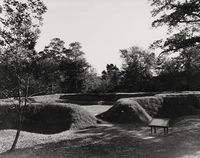Fort Raleigh: Difference between revisions
John Stanton (talk | contribs) m Text replace - "{{DEFAULTSORT:" to "|} {{DEFAULTSORT:" |
John Stanton (talk | contribs) No edit summary |
||
| Line 1: | Line 1: | ||
{{PageHeader}} | |||
{{SocialNetworks}} | {{SocialNetworks}} | ||
'''{{PAGENAME}}''' (1585-1587) - An early [[Colonial Period]] fort first established in 1585 on the north end of Roanoke Island, Dare County, North Carolina. First abandoned in 1586 and repopulated in 1587. Found abandoned in August 1590 with no sign of the colonists. | '''{{PAGENAME}}''' (1585-1587) - An early [[Colonial Period]] fort first established in 1585 on the north end of Roanoke Island, Dare County, North Carolina. First abandoned in 1586 and repopulated in 1587. Found abandoned in August 1590 with no sign of the colonists. | ||
{|{{FWpicframe}} | {|{{FWpicframe}} | ||
|- valign="top" | |- valign="top" | ||
|width="50%"|<!--[[Image:.jpg| | |width="50%"|<!--[[Image:.jpg|350px|thumb|left|Fort Raleigh]]--> | ||
|width="50%"|<!--[[Image:.jpg| | |width="50%"|<!--[[Image:.jpg|350px|thumb|right|Fort Raleigh]]--> | ||
|- | |- | ||
|colspan="2"|[[File:Fort Raleigh 101936pu.jpg|795px|thumb|center|Fort Raleigh Under Reconstruction]] | |colspan="2"|[[File:Fort Raleigh 101936pu.jpg|795px|thumb|center|Fort Raleigh Under Reconstruction]] | ||
|} | |} | ||
== History | == History == | ||
[[File:Fort Raleigh 101937pu.jpg|thumb|left|200px|Reconstructed Fort Raleigh Earthworks]] | [[File:Fort Raleigh 101937pu.jpg|thumb|left|200px|Reconstructed Fort Raleigh Earthworks]] | ||
Established in 1585 at the first English colony in America by Sir [[Richard Grenville]], a cousin of Sir [[Walter Raleigh]]. The settlement was originally populated in late July 1585 with 108 people who constructed the settlement and the fort on the island. This colony was unsuccessful and Sir Walter Raleigh took the survivors back to England in 1586. | Established in 1585 at the first English colony in America by Sir [[Richard Grenville]], a cousin of Sir [[Walter Raleigh]]. The settlement was originally populated in late July 1585 with 108 people who constructed the settlement and the fort on the island. This colony was unsuccessful and Sir Walter Raleigh took the survivors back to England in 1586. | ||
| Line 19: | Line 19: | ||
== Current Status == | == Current Status == | ||
Part of Fort Raleigh National Historic Site, Roanoke Island, Dare County, North Carolina. The reconstructed fort is now thought to be from a later period. | Part of Fort Raleigh National Historic Site, Roanoke Island, Dare County, North Carolina. The reconstructed fort is now thought to be from a later period. | ||
---- | ---- | ||
{| | {| | ||
| Line 53: | Line 37: | ||
'''Sources:''' | '''Sources:''' | ||
* {{Roberts}}, page 622. | * {{Roberts}}, page 622. | ||
* {{GNIS|ID=985324|}} | |||
'''Links:''' | '''Links:''' | ||
| Line 60: | Line 45: | ||
{{Visited|No}} | {{Visited|No}} | ||
__NOTOC__ | __NOTOC__ | ||
Revision as of 10:09, 17 February 2018
|
Fort Raleigh (1585-1587) - An early Colonial Period fort first established in 1585 on the north end of Roanoke Island, Dare County, North Carolina. First abandoned in 1586 and repopulated in 1587. Found abandoned in August 1590 with no sign of the colonists.
History Established in 1585 at the first English colony in America by Sir Richard Grenville, a cousin of Sir Walter Raleigh. The settlement was originally populated in late July 1585 with 108 people who constructed the settlement and the fort on the island. This colony was unsuccessful and Sir Walter Raleigh took the survivors back to England in 1586. The colony was repopulated with 150 colonists by John White in 1587. The settlement and the fort were rebuilt. John White returned to England for supplies but his return was delayed by a conflict between England and Spain. When he returned in August 1590 the colonists had disappeared without a trace. Now known as the "Lost Colony", the fate of the colonists remains unknown.
Current StatusPart of Fort Raleigh National Historic Site, Roanoke Island, Dare County, North Carolina. The reconstructed fort is now thought to be from a later period.
Visited: No
| ||||||
